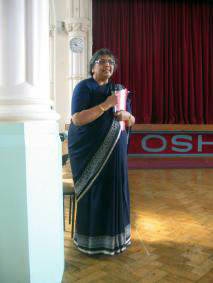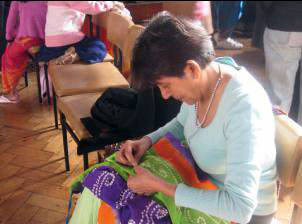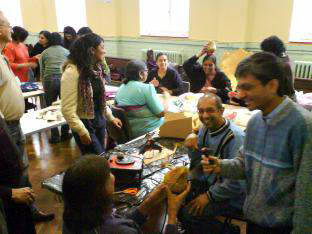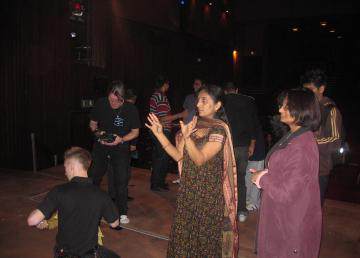8th April 2007, Easter Sunday, was the day when Shri Chandana Vidyapeeth, South London staged an original production of Tyagveer Shalibhadra. The production was designed as a family entertainment for the 21st Century, promoting our rich culture, high moral values and Mahavir Bhagvan’s teachings, as applicable within the constraints of the traditional story line. Not only was it original but it was produced by amateurs and presented at a professional theatre, Ashcroft Theatre at Fairfield Halls in Croydon, Surrey. Read on for “behind the scenes” stories of this production.
It was Prakashbhai Patalia’s dream that Shri Chandana Vidyapeeth, South London, performs at Ashcroft Theatre once again, after the successful productions of Mahavir Panch Kalyanak in 2000 and Bhagwan Shri Rushabhdev in 2002. So the venue was booked in April 2005 for April 2007. Prakashbhai and Ninaben, although holding the official position of administrators of the Vidyapeeth, are truly the backbone of the Vidyapeeth. One has to be involved in this organisation to fully appreciate their relentless efforts.
| |
The play script was written by Kusumben Shah, the head teacher of the Vidyapeeth. One of Kusumben’s missions has been to promote Gujarati language in Britain. She was the pioneer of the successful Gujarati classes in Croydon, originally started in the seventies as an extra-curricular activity. She has since worked on developing an education syllabus for this subject such that pupils are now able to attain GCSE and A Level qualifications in Gujarati. Kusumben is an examiner for these qualifications. So it is no surprise that the script was in Gujarati. Kusumben researched the numerous versions of this story and based her script on the essence of Jain values which are relevant to us today.
Once the play script was available, the teachers of Shri Chandana Vidyapeeth, South London started to work on the production. Contact was made with Bharti Gada, based in Mumbai, India, who wrote the lyrics to fit the script. The lyrics were received in November 2006 when Rakesh Shah got to work on the task of composing the music. Rakesh is a talented young man with ambitions to develop a career in media production. He attained a degree in Media Studies last summer. Singers Kishan Amin, Rakhee Haria and Avina Shah, all young amateur singers in their early twenties who sing for the joy of it, worked with Rakesh to produce the beautiful soundtrack for the production. The first track was approved by the teachers in December 2006. Following this approval, Rakesh composed the remaining soundtrack for the live performance and produced a CD version of the entire soundtrack for sale.
The next focus was on dance choreography. Harshaben Amin conducts Indian classical and folk dance classes as an extra curricular activity for interested youngsters. She willingly took on the task and spent an incredible amount of time and effort working with the young boys and girls from the Vidyapeeth and their friends, most of whom had very little training in Indian dancing. She was aptly helped by Naliniben and Shrutiben, two of the Vidyapeeth teachers. The final performance was highly commended by the audience for the dances representing Harshaben’s unique and original choreography.
Kusumben then focussed on assigning major speaking roles, obtaining costumes and designing stage scenes. The relentless practices commenced with the cast of sixty youngsters ranging from age 6 to 24. The enthusiasm of the young people quickly injected energy into the entire support network of parents, teachers and willing adult helpers. Each practice session resulted in yet another list of things to do! Prakashbhai and Ninaben continued to ensure that food and drink supplies were available to sustain the physical energy at each practice session.
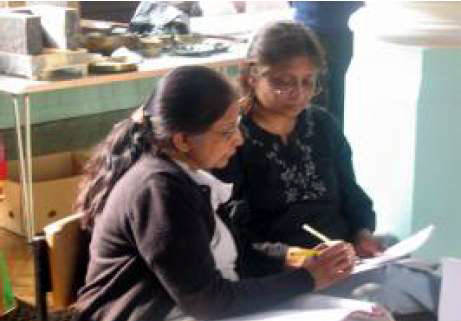 Preparing for script work with participants From left: Jyotsnaben Shah and Jytosnaben Samji |
|---|
Script learning and effective delivery was a challenge for these youngsters. Since being born in Britain, they have been exposed to English in every atmosphere of their lives, to the extent that English is their first language. The tone of expression and the accents required for Gujarati do not come naturally to them. Kusumben gave each participant a recording of their speaking lines to help with their memorising and delivery. The teachers, particularly Jyotsnaben Shah, Jyotsnaben Samji and Trusitben Shah spent many hours coaching moods and expressions relating to the ancient storyline. The young participants also spent many evenings with Kusumben preparing their delivery. The main participant, Rakhee Haria, as Bhadramata (Shalibhadra’s mother) was a lucky casting - she was remarkably calm, meticulous and patient as she persevered to memorise all her lines and polish up her performance.
The costumes were a combination of bargain purchases made by Ninaben during her several trips to India, Harshaben Amin’s costume stock and costumes that were made for previous productions. Many late nights were spent in considering the combinations and permutations to give the appropriate stage effect. It came to light during this preparation that, in the stock available, there were no suitable costumes for one particular scene where the treasure from heaven arrives at Shalibhadra’s residence. This scene required some special effects. Kusumben and Ninaben went on a quest to obtain suitable fabrics and Shrutiben, Minaben and others tailored the costumes for the twelve dancers - yet another challenge taken up by amateurs!
| |
|---|
A few days prior to the performance, Minaben, Lataben, Shrutiben and Naliniben, under Kusumben’s guidance organised and distributed the costumes and jewellery to all the participants. They also assisted with fitting and alterations, where necessary. This was a complex task as many participants had multiple costume changes representing their different roles in the production.
The settings for various scenes were donated by Rangeela Arts who have supported the Vidyapeeth since its first major production of Mahavir Panch Kalyanak. But work was still required to customise and adapt many of these items for their use in the production. The artistic talents of Kusumben Shah, Jyotsnaben Samji and Jyotsnaben Shah were fully utilised. Under their guidance, many helping hands and many late nights brought this task to its close only minutes before the final performance! Additionally, many endless hours were spent crafting numerous specific small items for the production. Another labour-intensive task was to fire proof all items that were to be used on the stage - a health and safety requirement at the theatre. Many hours were spent on spraying and drying the items with fire retardants.
Surely a production in a professional theatre had to be accompanied by a brochure! This task was also accomplished by the teachers, particularly Kamleshbhai Kothari and Vibhutiben Mehta with services from a printing company.
| |
Shri Chandana Vidyapeeth, South London is blessed with a very active Adult Support Group led by Ashwinbhai Shah. This group provided some of the funding, raised funds from friends and family, advertised and helped to sell the tickets. They were a reliable manpower that the teachers relied on, as they willingly took on and delivered to miscellaneous tasks.
On the day of the performance, each of the teachers had taken responsibility for specific tasks to ensure smooth management of all aspects like sound, lighting, scene changes, food, dressing, looking after the younger participants and keeping general order amongst the 60 enthusiastic participants. Stage and scene preparations commenced at 9.00 am and rehearsals for sound and light continued all day with numerous technical hitches, each one resolved as it occurred. Shear panic set in at around 5.00 pm upon realisation that the final performance had to go ahead with taking many chances on the technical aspects where the staff of Ashcroft Theatre was involved. The participants had no choice but to stop the rehearsal and to start getting ready for the performance. The dressing rooms became chaotic and excitement flourished.
| |
After the performance the flurry of activity continued back stage with all hands on deck as everything and everyone had to be out of the Theatre by 11.00 pm, just as the performance finished. It was no surprise that the departure time was missed by about half an hour, thus incurring an additional charge for the venue!
Although the performance was over, there was still a lot to do. The teachers got together again the following weekend to collect all the costumes from the participants and pack them suitably for any future productions. Similarly, the stage scenes were dismantled and those obtained from Rangeela Arts were packed and dispatched for safe return. The remaining were suitably packed and stored for future use, with an inventory compiled for reference.
However, the key point to note was that everyone, adult and child, who were involved in the production to whatever extent, worked with commitment and did their best, expecting nothing in return - a true demonstration of dedication. Many months, weeks, days and hours were occupied in creative thoughts and activities, uniting a community around a single goal. Mahavir Bhagwan’s teachings, embedded in the play script were memorised by many during the numerous rehearsals. It was a truly enjoyable and lasting experience for all.
 Vibhutiben Mehta
Vibhutiben Mehta
